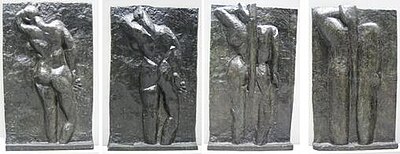| The Back Series | |
|---|---|
 | |
| Artist | Henri Matisse |
| Year | 1909–1930 |
| Type | Plaster / Bronze |
The Back Series is a series of four bas-relief sculptures, by Henri Matisse. They are Matisse's largest and most monumental sculptures. The plaster originals are housed in the Musée Matisse in Le Cateau-Cambrésis, France.
They were modeled between 1909 and 1930. Back (I) appeared in the second PostImpressionist show in London and the Armory Show in New York City.[1]
All four sculptures were unique plaster casts until 1950, when Back (I), (III), and (IV) were cast in bronze. Back (II) was rediscovered in 1955, a year after the artist’s death, and then cast. The series have been cast in a bronze edition of twelve, including one for the artist's family. Nine complete sets are housed in nine major museums around the world:[2]
- Musée National d'Art Moderne (Paris)[3][4][5][6]
- Tate (London)[7][8][9][10]
- Kunsthaus Zürich (Zürich)
- Staatsgalerie Stuttgart (Stuttgart)
- Museum of Modern Art (New York)[11][12][13][14]
- Hirshhorn Museum and Sculpture Garden (Washington D. C.)[15][16][17][18]
- Franklin D. Murphy Sculpture Garden (Los Angeles)[19][20][21][22]
- Kimbell Art Museum (Fort Worth)
- Lillie and Hugh Roy Cullen Sculpture Garden, Museum of Fine Arts (Houston)[23][24][25][26]
See also
[edit]References
[edit]- ^ Hilary Spurling (12 May 2007). "Hilary Spurling on Matisse's monolithic Back sculptures". the Guardian.
- ^ "Lot Notes of Henri Matisse, The Back (IV)". christies.com.
- ^ "Henri Matisse, Nu de dos, premier état". centrepompidou.fr.
- ^ "Henri Matisse, Nu de dos, deuxième état". centrepompidou.fr.
- ^ "Henri Matisse, Nu de dos, troisième état". centrepompidou.fr.
- ^ "Henri Matisse, Nu de dos, quatrième état". centrepompidou.fr.
- ^ "Henri Matisse, The Back (I), Tate". tate.org.uk.
- ^ "Henri Matisse, The Back (II), Tate". tate.org.uk.
- ^ "Henri Matisse, The Back (III), Tate". tate.org.uk.
- ^ "Henri Matisse, The Back (IV), Tate". tate.org.uk.
- ^ "Henri Matisse, The Back (I), MoMA". MoMA.org.
- ^ "Henri Matisse, The Back (II), MoMA". MoMA.org.
- ^ "Henri Matisse, The Back (III), MoMA". MoMA.org.
- ^ "Henri Matisse, The Back (IV), MoMA". MoMA.org.
- ^ "Henri Matisse, The Back (I), Hirshhorn Museum and Sculpture Garden". hirshhorn.si.edu.
- ^ "Henri Matisse, The Back (II), Hirshhorn Museum and Sculpture Garden". hirshhorn.si.edu.
- ^ "Henri Matisse, The Back (III), Hirshhorn Museum and Sculpture Garden". hirshhorn.si.edu.
- ^ "Henri Matisse, The Back (IV), Hirshhorn Museum and Sculpture Garden". hirshhorn.si.edu.
- ^ "Henri Matisse, The Back (I), Franklin D. Murphy Sculpture Garden". publicartinla.com.
- ^ "Henri Matisse, The Back (II), Franklin D. Murphy Sculpture Garden". publicartinla.com.
- ^ "Henri Matisse, The Back (III), Franklin D. Murphy Sculpture Garden". publicartinla.com.
- ^ "Henri Matisse, The Back (IV), Franklin D. Murphy Sculpture Garden". publicartinla.com.
- ^ "Henri Matisse, The Back (I), MFAH". mfah.org. Archived from the original on 7 March 2016.
- ^ "Henri Matisse, The Back (II), MFAH". mfah.org. Archived from the original on 7 March 2016.
- ^ "Henri Matisse, The Back (III), MFAH". mfah.org. Archived from the original on 7 March 2016.
- ^ "Henri Matisse, The Back (IV), MFAH". mfah.org. Archived from the original on 7 March 2016.
Well, that’s interesting to know that Psilotum nudum are known as whisk ferns. Psilotum nudum is the commoner species of the two. While the P. flaccidum is a rare species and is found in the tropical islands. Both the species are usually epiphytic in habit and grow upon tree ferns. These species may also be terrestrial and grow in humus or in the crevices of the rocks.
View the detailed Guide of Psilotum nudum: Detailed Study Of Psilotum Nudum (Whisk Fern), Classification, Anatomy, Reproduction